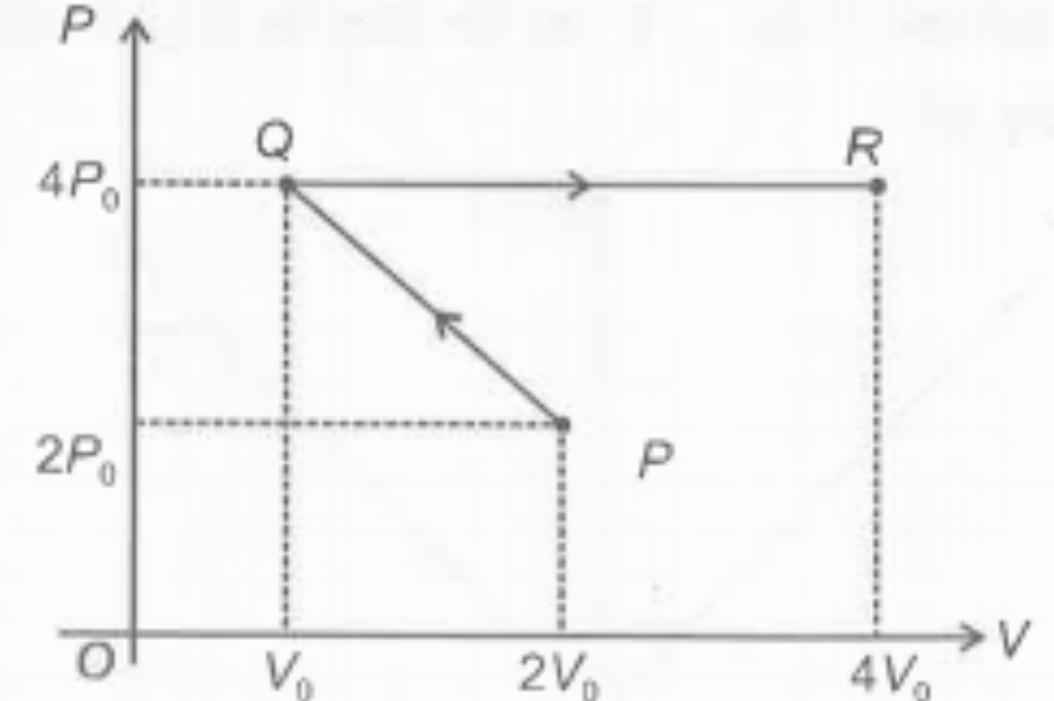An ideal diatomic gas with occupies a volume at a pressure . The gas undergoes a process in which the pressure is proportional to the volume. At the end of the process the rms speed of the gas molecules has doubled from its initial value.
Heat supplied to the gas in the given process is
The correct Answer is:C
To solve the problem step by step, we will analyze the given information and apply the relevant physics concepts.
Step 1: Understand the Initial Conditions
We have an ideal diatomic gas with:
- Heat capacity at constant volume, CV=5R2
- Initial volume V1 and initial pressure P1.
Step 2: Relate RMS Speed to Temperature
The RMS speed (vrms) of gas molecules is given by the formula:
vrms=√3RTM
where R is the universal gas constant, T is the absolute temperature, and M is the molar mass of the gas.
If the RMS speed doubles, we have:
v′rms=2vrms
This implies:
√3RT′M=2√3RTM
Squaring both sides gives:
3RT′M=4⋅3RTM
Cancelling 3RM from both sides, we find:
T′=4T
Step 3: Calculate the Change in Temperature
The change in temperature (ΔT) is:
ΔT=T′−T=4T−T=3T
Step 4: Analyze the Process
The problem states that pressure is proportional to volume:
P∝V⇒PV=k(constant)
This is characteristic of a polytropic process with n=−1.
Step 5: Calculate the Molar Heat Capacity for the Process
The molar heat capacity C for a polytropic process is given by:
C=CV+R1−n
Substituting CV=5R2 and n=−1:
C=5R2+R1−(−1)=5R2+R2=6R2=3R
Step 6: Calculate the Heat Supplied
The heat supplied (ΔQ) during the process is given by:
ΔQ=nCΔT
Substituting C=3R and ΔT=3T:
ΔQ=n(3R)(3T)=9nRT
Step 7: Relate to Ideal Gas Law
Using the ideal gas law PV=nRT, we can express nRT as:
nRT=P1V1
Thus, substituting this into our equation for heat:
ΔQ=9P1V1
Final Answer
The heat supplied to the gas in the given process is:
ΔQ=9P1V1
We have an ideal diatomic gas with:
- Heat capacity at constant volume, CV=5R2
- Initial volume V1 and initial pressure P1.
The RMS speed (vrms) of gas molecules is given by the formula:
vrms=√3RTM
where R is the universal gas constant, T is the absolute temperature, and M is the molar mass of the gas.
v′rms=2vrms
This implies:
√3RT′M=2√3RTM
Squaring both sides gives:
3RT′M=4⋅3RTM
Cancelling 3RM from both sides, we find:
T′=4T
The change in temperature (ΔT) is:
ΔT=T′−T=4T−T=3T
The problem states that pressure is proportional to volume:
P∝V⇒PV=k(constant)
This is characteristic of a polytropic process with n=−1.
The molar heat capacity C for a polytropic process is given by:
C=CV+R1−n
Substituting CV=5R2 and n=−1:
C=5R2+R1−(−1)=5R2+R2=6R2=3R
The heat supplied (ΔQ) during the process is given by:
ΔQ=nCΔT
Substituting C=3R and ΔT=3T:
ΔQ=n(3R)(3T)=9nRT
Using the ideal gas law PV=nRT, we can express nRT as:
nRT=P1V1
Thus, substituting this into our equation for heat:
ΔQ=9P1V1
The heat supplied to the gas in the given process is:
ΔQ=9P1V1
Similar Questions
An ideal diatomic gas with CV=5R2 occupies a volume V1 at a pressure P1. The gas undergoes a process in which the pressure is proportional to the volume. At the end of the process the rms speed of the gas molecules has doubled from its initial value.
The molar heat capacity of the gas in the given process is
View SolutionMolar heat capacity of an ideal gas in the process PVx = constant , is given by : C=Rγ−1+R1−x. An ideal diatomic gas with CV=5R2 occupies a volume V1 at a pressure P1. The gas undergoes a process in which the pressure is proportional to the volume. At the end of the process the rms speed of the gas molecules has doubled from its initial value.
The molar heat capacity of the gas in the given process is :-
View SolutionAn ideal diatomic gas with CV=5R2 occupies a volume (Vi at a pressure (Pi. The gas undergoes a process in which the pressure is proportional to the volume. At the end of the process, it is found that the rms speed of the gas molecules has doubles from its initial value. Determine the amount of energy transferred to the gas by heat.
View SolutionA gas undergoes a process in which its pressure P and volume V are related as VP = constant. The bulk modulus of gas for this process
View SolutionA gas undergoes a process in which its pressure P and volume V are related as VPn= constant. The bulk modulus of the gas in the process is:
View SolutionIn a process the pressure of a gas is inversely proportional to the square of the volume. If temperature of the gas increases, then work done by the gas:
View SolutionIn a process the pressure of a gas is inversely proportional to the square of the volume. If temperature of the gas increases, then work done by the gas:
View SolutionIn a process, the pressure of an ideal gas is proportional to square of the volume of the gas. If the temperature of the gas increases in this process, then work done by this gas
View SolutionAn ideal gas undergoes a process P→Q→R as shown in pressure (p) - volume (v) diagram.The work done by the gas is

View SolutionA monoatomic gas undergoes a process in which the pressure (P) and the volume (V) of the gas are related as PV−3=constant. What will be the molar heat capacity of gas for this process?
View Solution
